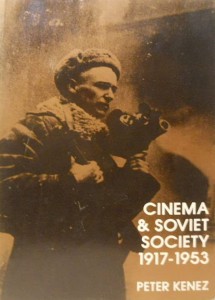Cinema and Soviet society, 1917-1953
de Peter Kenez


Moyenne des votes : ![]()
| 0 | vote | |
| 0 | vote | |
| 0 | vote | |
| 0 | vote |
Votre vote : -
Description de l'ouvrage:
In this history of Soviet cinema Peter Kenez describes the pre-revolutionary heritage, the changes brought about by the Revolution, the great flourishing of the golden years of the late 1920s, the constraints imposed on artists in the name of Socialist realism, the relative liberalization during the years of the Second World War, and the extraordinary repression during the gloomy last years of Stalin. The author's primary concern is the political uses of film. The Bolsheviks had high expectations: they believed that this medium would be a major vehicle for transmitting their social and political messages, and so experimented with the various ways with which they could bring movies to worker and peasant audiences. Although they achieved major successes, their unrealistically high expectations often led to disappointments and acrimonious debates. An examination of how the explicit and implicit messages in Soviet films changed over time helps us to understand the evolution of Soviet society. This study deals with the intersection of politics and culture and aims to illuminate both.In this history of Soviet cinema Peter Kenez describes the pre-revolutionary heritage, the changes brought about by the Revolution, the great flourishing of the golden years of the late 1920s, the constraints imposed on artists in the name of Socialist realism, the relative liberalization during the years of the Second World War, and the extraordinary repression during the gloomy last years of Stalin. The author's primary concern is the political uses of film. The Bolsheviks had high expectations: they believed that this medium would be a major vehicle for transmitting their social and political messages, and so experimented with the various ways with which they could bring movies to worker and peasant audiences. Although they achieved major successes, their unrealistically high expectations often led to disappointments and acrimonious debates. An examination of how the explicit and implicit messages in Soviet films changed over time helps us to understand the evolution of Soviet society. This study deals with the intersection of politics and culture and aims to illuminate both.
Voir le site internet de l'éditeur Cambridge University Press
> Sur un thème proche :
The Film Factory (2015)
Russian and Soviet Cinema in Documents 1896-1939
Dir. Richard Taylor et Ian Christie
Sujet : Countries > Russia / USSR
A Siberian History of Soviet Film (2024)
Manufacturing Visions of the Indigenous Peoples of the North
Sujet : Countries > Russia / USSR
Stalin's Final Films (2024)
Cinema, Socialist Realism, and Soviet Postwar Reality, 1945-1953
Sujet : Countries > Russia / USSR
Soviet Films of the 1970s and Early 1980s (2023)
Conformity and Non-Conformity Amidst Stagnation Decay
Dir. Marina Rojavin et Tim Harte
Sujet : Countries > Russia / USSR
Men Out of Focus (2021)
The Soviet Masculinity Crisis in the Long Sixties
Sujet : Countries > Russia / USSR
Feeling Revolution (2020)
Cinema, Genre, and the Politics of Affect under Stalin
Sujet : Countries > Russia / USSR
Cinema, State Socialism and Society in the Soviet Union and Eastern Europe, 1917-1989 (2017)
Re-Visions
Dir. Sanja Bahun et John Haynes
Sujet : Countries > Russia / USSR
Stalinist Cinema and the Production of History (2008)
Museum of the Revolution
Sujet : Countries > Russia / USSR
The Cinema of Russia and the Former Soviet Union (2007)
Dir. Birgit Beumers
Sujet : Countries > Russia / USSR